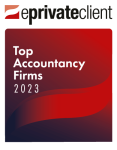11th January 2024
Under the Companies Act 2006, all UK businesses must prepare their financial statements within the accounting standards framework set by the UK Generally Accepted Accounting Principles (UK GAAP) or International Financial Reporting Standards (IFRS). UK GAAP is broken down into FRS 102, FRS 102 section 1A, FRS 105, and FRS 101.
FRS 101 is essentially a reduced disclosure framework of full IFRS allowing for less detailed disclosure than under full IFRs and is available to subsidiaries of a group where the parent of that group prepares publicly available consolidated financial statements, which are intended to give a true and fair view and that entity must be included in the consolidation.
FRS 102 section 1A is available to small companies and sets out a reduced disclosure framework available via exemptions that small companies can choose to apply.
The key accounting differences arise between IFRS and FRS 102 with FRS 101 and FRS 102 section 1A providing reduced disclosure frameworks of each accounting standard but apply the same recognition and measurement requirements.
Typically, we see smaller owner-managed businesses prepare their accounts under FRS 102 (and under the reduced disclosure framework, Section 1A, where applicable). We then see businesses taking on external funding through Venture Capital (VC) or Private Equity (PE), and consider a transition to IFRS, particularly where investment is coming from outside the UK. We often see businesses that are expanding internationally consider adopting IFRS, to align their global accounting standards. We see larger, owner-managed and investor backed businesses often use the IFRS framework for the consolidated position and may choose to utilise the reduced disclosure exemptions available under FRS 101 for the preparation of their subsidiary accounts. We see the majority of quoted or listed businesses preparing their accounts under IFRS (there are few occasions where this is not required).
What are the key differences?
Leases
IFRS
Under IFRS 16, almost all leases must be recognised on the balance sheet through corresponding right of use assets and lease liabilities. This is a complex calculation that involves the present value of lease payments with lease expenses then being presented as depreciation and interest.
Exemptions are available for low value or short-term assets, and these can continue to be accounted for on a straight-line basis over the lease term, and without recognition of a lease liability on the balance sheet.
FRS 102
FRS 102 divides leases into two categories: finance leases and operating leases. Finance leases are accounted for on the balance sheet as under IFRS, the difference arises in relation to operating leases.
FRS 102 operating leases do not affect the statement of financial position and are expensed over the term of the lease on a straight line or other appropriate basis.
Revenue
IFRS
IFRS 15 revenue follows an approach that is based on a control approach and generally recognises revenue when an entity transfers control of an asset to a customer. This is assessed under a 5-step model:
- Identify the contract.
- Identify separate performance obligations.
- Determine the transaction price.
- Allocate transaction price to performance obligations.
- Recognise revenue when each performance obligation is satisfied.
FRS 102
FRS 102 currently follows an approach that is based on a risks-and-reward approach and recognises revenue when costs can be reliably measured and it’s likely that the business will benefit economically.
Without the specifics of individual contracts, it is not possible to say if the accounting would be different under FRS 102 and IFRS. However, for many companies FRS 102 and IFRS have resulted in very different revenue recognition.
Development costs
IFRS
Under IFRS (IAS 38), it’s mandatory to capitalise development costs when the following criteria are met:
- The intangible asset will generate probable future economic benefits.
- There is intention to complete the intangible asset.
- The availability of adequate technical, financial and other resources to complete the development.
- The ability to use or sell the intangible asset.
- The technical feasibility of completing the intangible asset so that it will be available for use or sale.
- The ability to reliably measure the expenditure attributable to the intangible asset during its development.
IAS 38 permits intangible assets with both finite and indefinite useful lives.
FRS 102
Under FRS 102, there is a choice to either expense or capitalise development costs, even if they meet the capitalisation criteria provided this accounting policy is applied consistently. Recognition criteria are the same as under IFRS.
All intangible assets have finite useful lives under FRS 102, it is not possible to assign an indefinite useful life to any intangible asset. Where management are unable to make a reliable estimate of the useful life of an intangible asset, the amortisation period cannot exceed ten years. A useful economic life greater than ten years is allowed if management can reliably estimate the useful life of an asset, based on evidence.
Business combinations
IFRS
Transaction costs, such as legal fee’s under IFRS 3, are specifically excluded from the costs of an acquisition and are expensed as they are incurred.
Intangible assets acquired as part of a business combination are required to be separately recognised under IFRS 3 where these can be determined. These separately determined assets are then assigned appropriate useful lives and in extreme cases be indefinite. Under IFRS, goodwill is always assumed to have an indefinite useful life and as such is not amortised but is tested annually for impairment.
A gain on bargain purchase under IFRS 3 is immediately recorded in the statement of profit or loss.
FRS 102
Transaction costs, such as legal fee’s under FRS 102, are included in the cost of the acquisition.
All intangible assets have finite useful lives under FRS 102, it is not possible to assign an indefinite useful life to any intangible asset – be that separately identified assets or goodwill. Where management are unable to make a reliable estimate of the useful life of an intangible asset, the amortisation period (useful life) cannot exceed ten years and as such goodwill is usually amortised over ten years.
Under FRS 102 both positive and negative (gain on bargain purchase) goodwill are capitalised and amortised over their useful life.
Property plant and equipment
IFRS
Under IFRS (IAS 23 & IAS 11), borrowing costs that are directly attributable to the construction of an asset are treated as contract costs and therefore must be capitalised during the construction of the asset.
FRS 102
Under FRS 102, there is a choice to capitalise borrowing costs directly attributable to the construction of an asset or to expense these costs to the income statement as they occur.
Consolidation
Under FRS 102, companies can elect to not prepare consolidated financial statements when they qualify as a small group.
However, IFRS 10 requires all subsidiaries over which the parent company has control to be consolidated, unless the following four conditions are all met:
- The subsidiary is wholly owned or is a partially-owned subsidiary of another entity and all its other owners, including those not otherwise entitled to vote, have been informed about, and do not object to, the parent not presenting consolidated financial statements.
- The entities debt or equity instruments are not traded in a public market (a domestic or foreign stock exchange or an over-the-counter market, including local and regional markets).
- The entity did not file, nor is it in the process of filing, its financial statements with a securities commission or other regulatory organisation for the purpose of issuing any class of instruments in a public market.
- The entities ultimate or any intermediate parent produces financial statements that are available for public use and comply with IFRSs, in which subsidiaries are consolidated or are measured at fair value through profit or loss in accordance with this IFRS.
As such, consolidated financial statements must be presented under IFRS 10 regardless of the size of the group as a whole.
Forward planning?
Rarely will accounting differences alone be the deciding factor in which accounting standard is best for your business. There is no easy answer and there are a number of further factors to consider when making the choice, including:
- The cost of preparation – greater disclosure and calculation may be required under IFRS.
- Small companies’ exemptions under FRS 102 section 1A may be available.
- Group reporting requirements and cost of consolidation.
- International expansion – subsidiary group reporting adjustments in countries that have local GAAP but also allow for IFRS.
- International investment – IFRS provides for better comparability for shareholders/ investors.
- Stock exchange listing/admission – IFRS conversion required for IPO and beyond.
- Changes coming to FRS 102 to align with IFRS.





